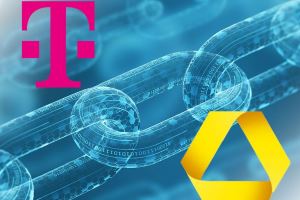Deutsche Telekom and Commerzbank are co-operating in the industrial sector. Together they are developing fully automated supply chains with integrated financial services. In this respect the Deutsche Telekom subsidiary T-Systems and Commerzbank are setting store by digital technologies such as 5G, artificial intelligence, the internet of things (IoT), blockchain, cloud technology and sensor technology. Corporate clients profit from the digital combination of physical and financial supply chains thanks to:
- More efficient, transparent and more resilient supply paths
- Intelligent warehouse management
- Improved access to liquidity
- Integrated automated financial services
- Cost reductions
Digital supply chains reduce costs and ensure transparency
The current geopolitical and economic situation has revealed the weakness of supply chains. Many supply paths are complex, static, lacking in transparency and involve numerous manual stages. They are designed to function when all the framework conditions remain constant and predictable. Error-proneness is high, as in the majority of cases physical and financial supply chains are not linked to one another digitally.
Above all for manufacturing companies a constant inventory, the timely delivery of the material required for production and its payment within the specified time are important. This physical process can be automated and digitized with modern technology. This is made possible by sensors on load carriers such as pallets, for example. With the aid of positioning technologies it is possible to establish the movement of goods along supply chains during transport between suppliers and producers (inter logistics) and a production facility (intra logistics).
This leads to the creation of databases: in the future producers, suppliers, transportation service providers and Commerzbank can communicate with one another digitally and in real time through their goods flows. Thus orders and payments may be triggered or specific financial services such as working capital optimisation, supply chain finance or risk mitigation can be automated.
In this respect technology standards and reference architectures guarantee secure and efficient data exchange between all the parties. Financial transactions are conducted on the basis of blockchain technology, with the foundation formed by so-called “smart contracts”, intelligent electronic contracts therefore. These contracts regulate which financial transactions are initiated with which predefined conditions, so-called triggers.
Logistician tests digital supply chain in the Werner von Siemens Centre
In a six-month test phase T-Systems and Commerzbank are optimising the digital solution together with a pilot customer from the logistics sector. The individual challenges faced by the customer in the supply process or in the warehouse are taken into consideration. To this end the infrastructure of the Werner von Siemens Centre in Berlin is being used. T-Systems operates a research and development hub for industry solutions there.
“Companies need technologies like 5G, IoT and the cloud share digital information with everyone in the supply chain globally. In the cooperation with Commerzbank we bring the worlds of technology and finance together so as to digitize all aspects of a supply chain from procurement, invoicing, through logistics, to payments,” says Urs M. Kramer, chief commercial officer at T-Systems.
Scalable solution for supply chains in Industry 4.0
“Supply chains will change rapidly with digital networking and integrated payments,” says Jorg Oliveri del Castillo-Schulz, chief operating officer of Commerzbank. “Together with T-Systems we are working on scalable solutions so that our customers can make their complex supply chains such that these are more efficient, resilient and productive.”
In this regard Commerzbank will also be supported with scientific expertise in the framework of its cooperation with the Fraunhofer Institute for Material Flow and Logistics (IML) in Dortmund. “Thanks to the integration of the blockchain-based solution which we are developing together with Commerzbank in the framework of the Trade Finance Innovations Lab, in the future the partners will be able to combine physical and financial supply chains with one another so as to attain economic end-to-end automation in supply chains,” says Prof. Dr. Dr. h. c. Michael Henke, institute head at Fraunhofer IML.
In addition, the cooperation is consciously setting store by an open ecosystem so as to facilitate integration into open source infrastructures such as the Silicon Economy of Fraunhofer Institute for Material Flow and Logistics IML, the International Data Spaces Association and also the European project Gaia-X, for example.
Comment on this article below or via Twitter: @IoTNow_OR @jcIoTnow










